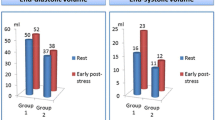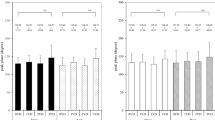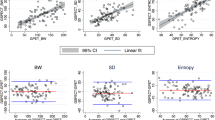Abstract
Transient alterations in ventricular conduction and synchronized cardiac performance have been reported in experimental models of myocardial ischemia. In post-stress 99mTc-sestamibi-gated-SPECT myocardial perfusion imaging (MPI), the time elapsed between tracer injection and image acquisition could influence the detection of ischemic left ventricular mechanical dyssynchrony (LVMD). We aimed at evaluating whether early vs. delayed post-stress MPI improve ischemic LVMD detection using the phase analysis parameters standard deviation (SD) and histogram bandwidth (HB) and to assess the correlation between stress-induced changes in SD and HB and other functional parameters. We prospectively studied 32 control subjects (Group-1) and 60 ischemic patients (Group-2). Stress-induced changes were calculated as stress minus rest (Δ). LVMD was defined as post-stress increases of either SD or HB. Group-2 showed higher ΔSD and ΔHB in early than in delayed images: early ΔSD: 1.63 (− 0.37 to 4.83) vs. delayed ΔSD: − 0.39 (− 3.82 to 1.74); early ΔHB: 2.50 (− 4 to 12) vs. ΔHB delayed: − 4 (− 15.75 to 4), all p < 0.01. ΔSD and ΔHB correlated linearly with ΔLV-ejection-fraction (EF) and ΔLV-end systolic-volume (ESV) in early images, all p < 0.01. Early images detected LVMD in more patients than delayed scans (78% vs. 38%; p < 0.01) All patients with LVEF drop in early post-stress evaluation had LVMD. Early post-stress images improve ischemic LVMD detection. Ischemic LVEF and LVESV changes correlate with ΔSD and ΔHB.




Similar content being viewed by others
Data availability
Not applicable.
Code availability
Not applicable.
References
Braunwald E, Kloner RA (1982) The stunned myocardium: prolonged, postischemic ventricular dysfunction. Circulation 66(6):1146–1149. https://doi.org/10.1161/01.cir.66.6.1146
Heiba SI, Santiago J, Mirzaitehrane M, Jana S, Dede F, Abdel-Dayem HM (2002) Transient postischemic stunning evaluation by stress gated Tl-201 SPECT myocardial imaging: effect on systolic left ventricular function. J Nucl Cardiol 9(5):482–490. https://doi.org/10.1067/mnc.2002.123855
Beardslee MA, Lerner DL, Tadros PN, Laing JG, Beyer EC, Yamada KA et al (2000) Dephosphorylation and intracellular redistribution of ventricular connexin43 during electrical uncoupling induced by ischemia. Circ Res 87:656–662. https://doi.org/10.1161/01.res.87.8.656
Sharir T, Germano G, Kavanagh PB, Lai S, Cohen I, Lewin HC et al (1999) Incremental prognostic value of post-stress left ventricular ejection fraction and volume by gated myocardial perfusion single photon emission computed tomography. Circulation 100(10):1035–1042. https://doi.org/10.1161/01.cir.100.10.1035
Carvalho PA, Aguiar PM, Grossman GB, Moraes JF, Baptista IS, Hirakata VN, Ludwig RTF, Ludwig EB (2012) Prognostic implications of the difference between left ventricular ejection fractions after stress and at rest in addition to the quantification of myocardial perfusion abnormalities obtained with gated SPECT. Clin Nucl Med 37(8):748–754. https://doi.org/10.1097/RLU.0b013e31825ae755
Bestetti A, Cuko B, Decarli A, Galli A, Lombardi F (2019) Additional value of systolic wall thickening in myocardial stunning evaluated by stress-rest gated perfusion SPECT. J Nucl Cardiol 26:833–840. https://doi.org/10.1007/s12350-017-1115-5
Chen J, Garcia EV, Folks RD, Cooke CD, Faber TL, Tauxe EL et al (2005) Onset of left ventricular mechanical contraction as determined by phase analysis of ECG-gated myocardial perfusion SPECT imaging: development of a diagnostic tool for assessment of cardiac mechanical dyssynchrony. J Nucl Cardiol 12:687–695. https://doi.org/10.1016/j.nuclcard.2005.06.088
Trimble MA, Velazquez EJ, Adams GL, Honeycutt EF, Pagnanelli RA, Barnhart HX et al (2008) Repeatability and reproducibility of phase analysis of gated single-photon emission computed tomography myocardial perfusion imaging used to quantify cardiac dyssynchrony. Nucl Med Commun 4:374–378. https://doi.org/10.1097/MNM.0b013e3282f81380
Lin X, Xu H, Zhao X, Folks RD, Garcia EV, Soman P et al (2010) Repeatability of left ventricular dyssynchrony and function parameters in serial gated myocardial perfusion SPECT studies. J Nucl Cardiol 5:811–816. https://doi.org/10.1007/s12350-010-9238-y
Peix A, Karthikeyan G, Massardo T, Kalaivani M, Patel C, Pabon LM et al (2019) Value of intraventricular dyssynchrony assessment by gated-SPECT myocardial perfusion imaging in the management of heart failure patients undergoing cardiac resynchronization therapy (VISION-CRT). J Nucl Cardiol. https://doi.org/10.1007/s12350-018-01589-5
Song ZZ (2008) Can LV dyssynchrony as assessed with phase analysis on gated myocardial perfusion SPECT preferably predict response to CRT? J Nucl Med 49(4):686. https://doi.org/10.2967/jnumed.107.049601
Malik D, Mittal BR, Sood A, Parmar M, Kaur K, Bahl A (2018) Prognostic value of left ventricular mechanical dyssynchrony indices in long-standing type II diabetes mellitus with normal perfusion and left ventricular systolic functions on SPECT-MPI. J Nucl Cardiol. https://doi.org/10.1007/s12350-018-1436-z
Caobelli F, Popescu CE, Laudicella R, Comis A, Pignata SA, Saea R et al (2018) Predictive and prognostic value of left ventricular mechanical dyssynchrony assessed by myocardial perfusion single photon emission computed tomography in asymptomatic patients under hemodialysis. Nucl Med Commun 39(5):423–429. https://doi.org/10.1097/MNM.0000000000000816
Peix A, Padrón K, Cabrera LO, Pardo L, Sánchez J (2019) Left ventricular mechanical dyssynchrony in patients with chest pain and normal epicardial coronary arteries. J Nucl Cardiol. https://doi.org/10.1007/s12350-019-01804-x
Hida S, Chikamori T, Tanaka H, Igarashi Y, Shiba C, Usui Y et al (2012) Diagnostic value of left ventricular dyssynchrony after exercise and at rest in the detection of multivessel coronary artery disease on single-photon emission computed tomography. Circ J 76:1942–1952. https://doi.org/10.1253/circj.cj-11-1392
Mut F, Giubbini R, Vitola J, Lusa L, Sobic-Saranovic D, Peix A et al (2014) Detection of post-exercise stunning by early gated SPECT myocardial perfusion imaging: results from the IAEA multi-center study. J Nucl Cardiol 21:1168–1176. https://doi.org/10.1007/s12350-014-9983-4
Sobic-Saranovic DP, Bojic L, Petrasinovic Z, Grozdic-Milojevic IT, Pavlovic S, Artiko V, Jaksic E, Obradovic V, Dondi M (2013) Diagnostic and prognostic value of gated SPECT MIBI early post-stress imaging in patients with intermediate Duke Treadmill Score. Clin Nucl Med 38(10):784–789. https://doi.org/10.1097/RLU.0b013e31829f8e5a
Henzlova MJ, Duvall WL, Einstein AJ, Travin MI, Verberne HJ (2016) ASNC imaging guidelines for SPECT nuclear cardiology procedures: stress, protocols and tracers. J Nucl Cardiol 23(3):606–639. https://doi.org/10.1007/s12350-015-0387-x
Dorbala S, Ananthasubramaniam K, Armstrong IS et al (2018) Single photon emission computed tomography (SPECT) myocardial perfusion imaging guidelines: instrumentation, acquisition, processing, and interpretation. J Nucl Cardiol 25:1784–1846. https://doi.org/10.1007/s12350-018-1283-y
Tilkemeier PL, Bourque J, Doukky R et al (2017) ASNC imaging guidelines for nuclear cardiology procedures. J Nucl Cardiol 24:2064–2128. https://doi.org/10.1007/s12350-017-1057-y
Chen CC, Shen TY, Chang MC, Hung GU, Chen WC, Kao CH et al (2012) Stress-induced myocardial ischemia is associated with early post-stress left ventricular mechanical dyssynchrony as assessed by phase analysis of 201Tl gated SPECT myocardial perfusion imaging. Eur J Nucl Med Mol Imaging 39:1904–1909. https://doi.org/10.1007/s00259-012-2208-7
Singh H, Patel CD, Sharma P, Naik N, Singh S, Narang R (2015) Does perfusion pattern influence stress-induced changes in left ventricular mechanical dyssynchrony on thallium-201-gated SPECT myocardial perfusion imaging? J Nucl Cardiol 22(1):36–43. https://doi.org/10.1007/s12350-014-9979-0
Johnson LL, Verdesca SA, Aude WY, Xavier RC, Nott LT, Campanella MW, Germano G (1997) Postischemic stunning can affect left ventricular ejection fraction and regional wall motion on post-stress gated sestamibi tomograms. J Am Coll Cardiol 30:1641–1648. https://doi.org/10.1016/s0735-1097(97)00388-4
Marrugat J, Vila J, Pavesi M, Sanz F (1998) Estimation of the sample size in clinical and epidemiological investigations. Med Clin 111:267–276
Peix A, Cabrera LO, Padrón K, Rodríguez L, Fernández J, López G et al (2018) Association between non-perfusion parameters and presence of ischemia in gated-SPECT myocardial perfusion imaging studies. J Nucl Cardiol 25(2):609–615. https://doi.org/10.1007/s12350-016-0728-4
Camilletti J, Erriest J, Espinola-Zavaleta N, Hernández-Sandoval S, Redolatti M, Cartasegna L et al (2018) Left ventricular dyssynchrony and abnormalities in wall motion, assessed by gated-SPECT as ischemic auxiliary markers. J Nucl Cardiol. https://doi.org/10.1007/s12350-018-01544-4
AlJaroudi W, Alraies MC, Menon V, Brunken RC, Cerqueira MD, Jaber WA (2012) Predictors and incremental prognostic value of left ventricular mechanical dyssynchrony response during stress-gated positron emission tomography in patients with ischemic cardiomyopathy. J Nucl Cardiol 19(5):958–969. https://doi.org/10.1007/s12350-012-9592-z
Sharir T, Bacher-Stier C, Dhar S, Lewin HC, Miranda R, Friedman JD et al (2000) Identification of severe and extensive coronary artery disease by postexercise regional wall motion abnormalities in Tc-99m sestamibi gated single-photon emission computed tomography. Am J Cardiol 86:1171–1175. https://doi.org/10.1016/s0002-9149(00)01206-6
Lima RS, Watson DD, Goode AR, Siadaty MS, Ragosta M, Beller GA, Habib SH (2003) Incremental value of combined perfusion and function over perfusion alone by gated SPECT myocardial perfusion imaging for detection of severe three-vessel coronary artery disease. J Am Coll Cardiol 42(1):64–70. https://doi.org/10.1016/s0735-1097(03)00562-x
Kapetanopoulos A, Ahlberg AW, Taub CC, Katten DM, Heller GV (2007) Regional wall-motion abnormalities on post-stress electrocardiographic-gated technetium-99m sestamibi single-photon emission computed tomography imaging predict cardiac events. J Nucl Cardiol 14:810–817. https://doi.org/10.1016/j.nuclcard.2007.07.014
Acknowledgements
The authors thank Dr. Roxana Campisi and Dr. Gustavo Giunta for their thoughtful suggestions in the preparation of this manuscript.
Funding
Not applicable.
Author information
Authors and Affiliations
Corresponding author
Ethics declarations
Conflict of interest
The authors declare that they have no conflict of interest.
Ethical approval
This study complies with the Declaration of Helsinki of 1964 and all subsequent revisions and was approved by the Ethics Committee of the Favaloro Foundation University Hospital.
Consent to participate
Written informed consent was obtained from all individual participants included in the study.
Consent for publication
Not applicable.
Additional information
Publisher's Note
Springer Nature remains neutral with regard to jurisdictional claims in published maps and institutional affiliations.
Rights and permissions
About this article
Cite this article
Cortés, C.M., Aramayo G, E.N., Barboza, P.E. et al. Impact of early post-stress 99mTc sestamibi ECG-gated SPECT myocardial perfusion imaging on the detection of ischemic LV dyssynchrony: an early step in the stunning cascade. Int J Cardiovasc Imaging 37, 1789–1798 (2021). https://doi.org/10.1007/s10554-020-02145-4
Received:
Accepted:
Published:
Issue Date:
DOI: https://doi.org/10.1007/s10554-020-02145-4




